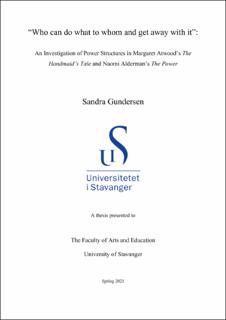| dc.description.abstract | This thesis explores the conditions that constitute and uphold a power hierarchy, emphasised by the two feminist dystopian novels The Handmaid’s Tale by Margaret Atwood and The Power by Naomi Alderman. The two novels in question both depict a future society that reflects the oppression of women in our contemporary patriarchal society, and reveal how different cultural and social tools, such as language, ideology and gender roles, are used to establish and uphold power structures within a society. Furthermore, this thesis calls attention to the relationship between physical power and structural power. It will show how power is imbedded within our ideology and what role ideology plays in our social structures. This thesis will examine the ways in which the novels examine these tools through close readings with particular emphasis on the narrators and protagonists. To conclude, this thesis discusses the following questions, who has control over whom, and what devices do the authorities in the novels use to establish their power? | |
